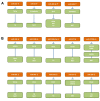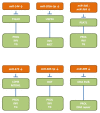MicroRNAs and Corresponding Targets in Esophageal Cancer as Shown In Vitro and In Vivo in Preclinical Models
- PMID: 35181582
- PMCID: PMC8865044
- DOI: 10.21873/cgp.20308
MicroRNAs and Corresponding Targets in Esophageal Cancer as Shown In Vitro and In Vivo in Preclinical Models
Abstract
Squamous cell carcinoma of the esophagus is associated with a dismal prognosis. Therefore, identification of new targets and implementation of new treatment modalities are issues of paramount importance. Based on a survey of the literature, we identified microRNAs conferring antitumoral activity in preclinical in vivo experiments. In the category of miRs targeting secreted factors and transmembrane receptors, four miRs were up-regulated and 10 were down-regulated compared with five out of nine in the category transcription factors, and six miRs were down-regulated in the category enzymes, including metabolic enzymes. The down-regulated miRs have targets which can be inhibited by small molecules or antibody-related entities, or re-expressed by reconstitution therapy. Up-regulated miRs have targets which can be reconstituted with small molecules or inhibited with antagomirs.
Keywords: miR-based target identification; miR-related treatment modalities; preclinical in vivo models; review; squamous cell esophageal cancer.
Copyright © 2022, International Institute of Anticancer Research (Dr. George J. Delinasios), All rights reserved.
Conflict of interest statement
AN is and UHW was an employee of Roche.
Figures



Similar articles
-
Long Non-coding RNAs Sponging MicroRNAs With Efficacy in Preclinical In Vivo Models of Esophageal Squamous Cell Cancer.Anticancer Res. 2022 Jul;42(7):3233-3249. doi: 10.21873/anticanres.15813. Anticancer Res. 2022. PMID: 35790246 Review.
-
Circular RNAs With Efficacy in Preclinical In Vitro and In Vivo Models of Esophageal Squamous Cell Carcinoma.Cancer Genomics Proteomics. 2022 May-Jun;19(3):283-298. doi: 10.21873/cgp.20320. Cancer Genomics Proteomics. 2022. PMID: 35430563 Free PMC article.
-
Long Non-coding RNAs With In Vitro and In Vivo Efficacy in Preclinical Models of Esophageal Squamous Cell Carcinoma Which Act by a Non-microRNA Sponging Mechanism.Cancer Genomics Proteomics. 2022 Jul-Aug;19(4):372-389. doi: 10.21873/cgp.20327. Cancer Genomics Proteomics. 2022. PMID: 35732324 Free PMC article. Review.
-
A 10‑microRNA prognosis scoring system in esophageal squamous cell carcinoma constructed using bioinformatic methods.Mol Med Rep. 2018 Apr;17(4):5222-5228. doi: 10.3892/mmr.2018.8550. Epub 2018 Feb 2. Mol Med Rep. 2018. PMID: 29393486 Free PMC article.
-
MiR-150 is associated with poor prognosis in esophageal squamous cell carcinoma via targeting the EMT inducer ZEB1.Cancer Sci. 2013 Jan;104(1):48-54. doi: 10.1111/cas.12030. Epub 2012 Nov 8. Cancer Sci. 2013. PMID: 23013135 Free PMC article.
Cited by
-
Circ_0001093 promotes glutamine metabolism and cancer progression of esophageal squamous cell carcinoma by targeting miR-579-3p/glutaminase axis.J Bioenerg Biomembr. 2022 Apr;54(2):119-134. doi: 10.1007/s10863-022-09935-6. Epub 2022 Mar 23. J Bioenerg Biomembr. 2022. PMID: 35322289
References
Publication types
MeSH terms
Substances
LinkOut - more resources
Full Text Sources
Medical
